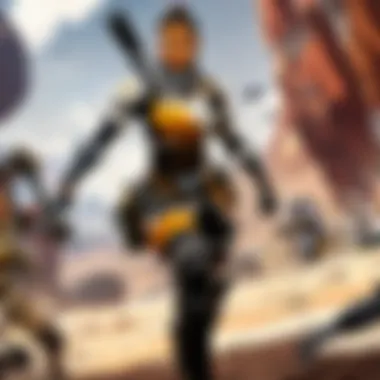AGL Tournament: Apex Legends Competitive Insights


Intro
The AGL tournament holds significant importance within the competitive gaming environment of Apex Legends. As gamers seek to refine their skills and teams look for ways to improve their chances of victory, understanding the nuances of tournaments like AGL becomes critical. In this analysis, we will cover several essential factors, including game updates, character guides, weapon analysis, and strategies that can aid both players and enthusiasts in navigating competitive play effectively.
Game Updates and Patch Notes
Keeping pace with the ever-evolving AGL tournament requires awareness of recent game updates and their implications for players.
Summary of Recent Game Updates
The Apex Legends development team routinely implements updates that impact gameplay significantly. Often these updates address game balance, bug fixes, and performance enhancements. Staying alert to these changes is essential since even small adjustments can shift the competitive meta.
Detailed Breakdown of Patch Notes and Changes
An assessment of the patch notes is crucial for understanding how specific characters and weapons have been modified. For instance, alterations to weapon damage, rate of fire, or character abilities can influence team strategies during the tournament. Here are key changes to look for in the latest patch notes:
- Weapon adjustments: Increases or decreases in damage values.
- Character abilities: Modifications to cooldown times or effectiveness of skills.
- Map updates: New routes, locations, or environmental hazards can alter player tactics significantly.
Character Insights
A successful team in the AGL tournament relies on a strong understanding of character strengths and playstyles.
Overview of Character Abilities and Playstyle
Each character in Apex Legends brings unique abilities to the table, which can sway the outcome of a match. Familiarity with character abilities allows for better team coordination and synergy.
Tips and Strategies for Mastering Each Character
- Wraith: Master her portal ability for strategic escapes or ambushes.
- Gibraltar: Utilize his dome shield effectively to revive teammates safely.
- Bloodhound: Use tracking abilities to locate enemies and gain the upper hand in engagements.
Weapon Analysis and Loadout Suggestions
Weapons play a vital role in achieving victory in the AGL tournament setting. Weapon selection must align with individual playstyles and team strategies.
Analysis of Weapon Stats and Effectiveness
Weapons vary in stats like damage per shot, fire rate, and accuracy. Understanding these stats can guide players in their weapons of choice.
Recommended Weapon Loadouts for Different Playstyles
- Aggressive loadout: R-99 submachine gun and Mastiff shotgun for close combat.
- Mid-range loadout: R-301 carbine and Hemlok for versatility.
- Sniper loadout: Longbow and Triple Take for long-range engagements.
Game Strategies and Tips
To excel in the competitive realm of the AGL tournament, players must employ cohesive strategies.
Strategies for Different Game Modes and Scenarios
Different game modes, like Battle Royale or Arena, require specific strategies. For instance, in Battle Royale, focusing on positioning and rotations is critical, while in Arena, tight team coordination and communication can prove decisive.
Tips for Improving Gameplay Mechanics and Decision-Making
- Review game footage to identify mistakes and learn from them.
- Communicate consistently with teammates for strategic planning.
- Stay adaptable in the face of changing situations on the battlefield.
The ability to adjust your strategy in real-time can turn the tide in competitive matches.
By understanding these aspects of the AGL tournament, players can enhance their performance and increase their chances of success in Apex Legends. The competition can be fierce, but with the right knowledge, preparation and teamwork, achieving victory is within reach.


Overview of the AGL Tournament
The AGL Tournament serves as a pivotal focal point within the competitive landscape of Apex Legends. Understanding its significance aids in grasping the broader context of the game and its community. Players and spectators alike benefit from analyzing how this tournament shapes competitive gaming.
The AGL Tournament not only showcases the skills of top-tier players but also reflects the evolving strategies and dynamics of Apex Legends. Its importance lies in fostering a competitive environment where players can develop and demonstrate their skills under pressure. Furthermore, it offers vital opportunities for newer players to witness high-level play, potentially sharpening their own gameplay through observation.
History of the AGL Tournament
The AGL Tournament began as a niche competition but quickly evolved into a cornerstone of the Apex Legends esports scene. Initially launched to promote competitive play, it has seen an increase in both participants and audience engagement since its inception. The tournament's early days focused on grassroots efforts, allowing local teams to compete, which nurtured talent at various skill levels.
As Apex Legends gained traction, the AGL Tournament adapted its structure to accommodate a growing player base. This evolution marked significant milestones such as the introduction of new rules, expanded formats, and increased sponsorship. Each iteration has been characterized by a desire to elevate the competitive experience, leading to memorable matches and standout performances. Such developments contribute to the overall prestige and allure of the tournament.
Tournament Structure and Format
The structure and format of the AGL Tournament play a crucial role in determining how teams perform and strategize. Each tournament season typically comprises multiple stages, including qualifying rounds, group stages, and finals. This layered format ensures a fair platform for teams to demonstrate their proficiency.
Matches in the AGL Tournament often follow a battle royale format, where teams accumulate points based on their performance. This could be through eliminations or placements in the match. Point allocation is critical; it emphasizes not only individual skills but also teamwork and communication.
Moreover, the tournament implements various game modes and maps, which adds complexity. Teams must be adaptable, adjusting strategies based on the dynamic environments. This adaptability is key to succeeding in the AGL, and it continuously refines team compositions and tactics as they respond to shifting challenges.
"The AGL Tournament emphasizes not just individual prowess, but crucially, the synergy within teams."
Key Elements of Competitive Apex Legends
In the realm of competitive gaming, specifically within Apex Legends, understanding the core elements is vital. These components shape how players approach matches and can significantly influence outcomes in tournaments like the AGL. This section focuses on two critical aspects: game mechanics and the role of characters. Mastery of these areas is not only beneficial for individual players but also essential for team-based strategies.
Understanding Game Mechanics
Game mechanics form the backbone of Apex Legends. They dictate how players interact with the environment and each other. Familiarity with these mechanics can provide players a competitive edge. Understanding elements such as gunplay, movement, and map layout is crucial.
Movement mechanics in Apex Legends include sliding, climbing, and zip-lining. Effectively using these features can allow players to gain superior positioning over opponents. For example, players can evade fire by utilizing a combination of grappling and wall running. This showcases not only skill but also a keen understanding of the game’s mechanics.
When it comes to gunplay, the precision in shooting is equally significant. Each weapon in Apex Legends behaves differently. Knowing the recoil patterns and damage scaling can dramatically affect engagement outcomes. Moreover, mastering attachments and their effects on weapons can empower players.
Additionally, the importance of the tactical environment must not be underestimated. The layout of the map can create strategic advantages or disadvantages, depending on players’ choices. Working with the terrain can be as essential as aiming or shooting.
Role of Characters and Legends
In Apex Legends, the choice of character—known as Legends—has profound implications for team dynamics. Each Legend possesses unique abilities that can shape the course of a match. Recognizing how these abilities complement team composition is essential for success in the AGL Tournament.
For instance, playing a defensive Legend like Gibraltar can provide protective benefits to a team, while a support Legend such as Lifeline ensures sustainability through healing and reviving. It’s crucial for players to assess which Legends work well together. A balanced composition often leads to better synergy and effectiveness during gameplay.
*
In competitive Apex Legends, the synergy between Legends can often determine the match outcome. A well-rounded team can adapt and overcome various challenges posed by opponents.
*
Moreover, understanding the meta of Legends can greatly influence performance. The current trends determine which Legends are favored in competitive play. Adjusting to these shifts is vital for maintaining relevance in the tournament landscape. Teams must constantly adapt their strategies based on the evolving preferences for certain Legends.
Team Strategies in the AGL Tournament
In the world of competitive Apex Legends, team strategies play a crucial role in determining success. The AGL Tournament showcases high-level gaming where decision-making, coordination, and execution of strategies can differentiate winning teams from those that fall short. Understanding the nuances of team dynamics is essential, as these strategies ultimately influence not only individual player performance but also the overall trajectory of the tournament.
Composition of Winning Teams
The composition of a team in the AGL Tournament is a deliberate process. Players often select legends that complement each other's abilities, maximizing their potential for synergy. Typically, successful teams consist of three roles: damage dealers, support characters, and controllers.
- Damage Dealers: Legends like Wraith and Octane provide high mobility and lethal firepower. They are often crucial in pushing forward and securing kills.
- Support Characters: Lifeline or Gibraltar can provide healing or a shield for teammates, enhancing survivability during intense firefights.
- Controllers: Legends such as Caustic control space and manipulate engagements, providing strategic advantages in closed quarters.


The balance of these roles is vital. Misalignment in character selection can lead to weaknesses that opponents may exploit. Therefore, teams often undergo extensive practice to ensure cohesive strategy and teamwork.
Adaptability to Changing Circumstances
Adaptability is another essential trait of teams in the AGL Tournament. The game’s unpredictable nature demands players quickly adjust to myriad variables such as opponent movements, zone changes, and loot availability.
Knowing how to shift strategies can be a game-changer. For example:
- Rotation: Teams often need to alter their path depending on the circle's location. This requires real-time decision-making and communication.
- Engagement Decisions: Sometimes, opting to avoid a team fight is wiser, preserving resources for later. Teams that can recognize when to engage and when to retreat showcase a high level of strategic thinking.
- Legend Utilization: If one strategy isn't working, teams might need to adapt the use of their legends on the fly. This might mean using abilities creatively or switching up their approach in battles.
"The best teams are those that can evolve mid-match. They don't just react; they anticipate."
Player Performance Analysis
Analyzing player performance is critical to understanding success in the AGL Tournament and competitive gaming in general. It provides insights into both individual and team dynamics. Understanding specific elements, such as kill-death ratios and teamwork, can highlight areas for improvement. Moreover, performance insights can guide future strategies, helping teams adapt and evolve.
Statistical Insights
Statistical analysis in Apex Legends extends beyond just kills or wins. Metrics like damage dealt, survival time, and healing statistics paint a clearer picture of a player's contribution to the team.
- Kill-to-Death Ratio: This ratio shows how often a player secures kills compared to their deaths. A higher ratio often indicates aggressive play and skill.
- Damage Output: The amount of damage dealt to opponents can reflect a player's impact in engagements. Some players excel in support roles, dealing less damage while focusing on reviving teammates.
- Win Rates: Tracking win rates across various maps can offer insights on player adaptability and effectiveness in different settings.
Using data analysis tools can lead to deeper insights. Platforms that track gameplay metrics allow coaches and players to highlight strengths and weaknesses. This is valuable information for both individual players and teams.
Psychological Factors in Competition
Psychological factors play a significant role in competitive performance. The pressure of tournaments like the AGL can affect players’ mental state. Understanding these elements can lead to improved performance.
- Stress Management: High-stakes situations can lead to anxiety. Training to cope with stress might improve performance under pressure.
- Team Communication: Effective communication can enhance team cohesion. Players who encourage and guide each other tend to perform better.
- Focus and Concentration: Maintaining focus during intense matches is essential. Players often develop routines and strategies to enhance their concentration.
"Improving psychological resilience can be as important as technical skills in competitive gaming."
In summary, a comprehensive approach to player performance analysis involves both statistical metrics and psychological understanding. This dual focus creates a more robust foundation for competitive success, enabling players and teams to refine their strategies and boost overall performance in the AGL Tournament.
Impact of the AGL Tournament on the Community
The AGL Tournament serves as a vital touchpoint for the Apex Legends community. The influence of competitive events reaches far beyond the games themselves. It fosters a sense of belonging and empowerment among players and fans. By participating in these tournaments, individuals gain the opportunity to showcase their skills, learn from peers, and engage with a broader audience. The tournament impacts community engagement in multiple dimensions.
Engagement and Participation Metrics
In analyzing the impact of the AGL Tournament, it is essential to examine engagement and participation metrics. These data points provide insight into how actively players and fans interact with the competitive scene. Some key metrics include:
- Player Registration: The number of teams and individuals participating in the tournament reflects community interest. Higher participation often indicates a vibrant competitive scene.
- Viewership Numbers: Tracking how many viewers tune in during live broadcasts shows the level of interest and investment in the tournament.
- Social Media Interactions: Metrics such as likes, shares, and comments on platforms like Facebook and Reddit gauge community discussions and enthusiasm.
Each of these metrics tells a story about the health and growth of the community. They highlight how the tournament not only sparks competition but also unites players with shared interests.
Community Reactions and Feedback
The community’s reactions and feedback are critical in understanding the AGL Tournament's place in Apex Legends culture. Players express their views through forums and social media platforms. This direct feedback loop allows organizers to adapt and improve future events.
Key aspects of community feedback include:
- Event Quality: Players often discuss the overall quality of the tournament including gameplay, organization, and production values. Positive feedback reinforces the event's success.
- Inclusivity: Insights into whether the tournament is seen as inclusive or if it needs improvement reflect on how diverse the participant pool is.
- Future Expectations: Players share what they hope to see in future tournaments. This input shapes the direction of upcoming seasons and influences community sentiment.
"Feedback from the community is essential for the evolution of gaming tournaments. The AGL Tournament consistently aims to meet the expectations set by its dedicated players."
Efforts to engage the community yield constructive dialogue and foster a spirit of collaboration. Overall, the AGL Tournament acts as a catalyst that strengthens not only the game of Apex Legends but also the community surrounding it.


The Evolving Meta of Apex Legends
The concept of the meta is fundamental in competitive gaming, particularly in a battle royale like Apex Legends. The evolving meta refers to how strategies, character selections, and gameplay styles shift over time, often influenced by updates from the developers, player preferences, and emerging trends within the community. Understanding the meta is critical for players aiming to improve their performance and ensure they are competitive in high-level play, especially within the AGL Tournament.
Trends in Character Usage
In Apex Legends, the choices players make regarding which characters to use can significantly impact team dynamics and overall strategy. Regular introduction of new Legends and periodic balance changes from Respawn Entertainment can rapidly alter the character landscape. Some Legends may become favored due to their utility or synergy with current team compositions.
For example, characters like Wraith and Octane have often seen a rise in usage due to their mobility skills, allowing teams to reposition and engage or disengage effectively. Conversely, characters can lose favor; if their abilities are nerfed, as seen in past updates with legends like Caustic or Gibraltar, they may be relegated to niche roles or lesser-used picks.
Here are some notable trends from past seasons:
- Increased usage of aggressive Legends: Characters who can secure early eliminations are preferred in the current meta.
- Diversity in team compositions: Teams are increasingly experimenting with mixed compositions, combining damage dealers with healers or support roles for better overall balance.
- Adaptation to tournament strategies: During AGL Tournaments, teams often align their picks closely with predicted trends, making character selection a chess-like decision.
Map Changes and Their Influences
Map changes are another vital aspect that shapes the meta. Respawn Entertainment frequently updates the environments of Apex Legends, creating opportunities for new strategies and altering how teams approach engagements. Changes may involve new locations, adjustments to loot spawns, or even alterations to terrain elevation, which can have profound effects on gameplay.
For instance, upon introducing new points of interest in the Kings Canyon map, players must reassess their drop strategies and rotation paths. A new high-ground location can suddenly become a contested hotspot, shifting focus and shifting character usage patterns.
Some impactful changes observed include:
- New points of interest attracting highly aggressive gameplay: With popular spots like Bonecage or The Rig continuously evolving, teams must adapt to the resulting rush for resources.
- Modifications to existing structures increasing verticality: Adjustments that enable more vertical combat push teams to utilize characters with movement capabilities effectively.
- Adjustments that promote longer-range engagements: If a map becomes more open, characters with long-range abilities may see increased utility.
Understanding the meta is not just about knowing what is strong or weak; it is recognizing how to adapt your strategy to opponents and changes in the game environment.
Future of the AGL Tournament
The future of the AGL tournament holds significant importance within the broader narrative of competitive Apex Legends. Good understanding of its trajectory can offer insights into not only how the tournament itself will evolve, but also how it may impact the community and players alike. The competitive gaming environment is ever-changing, and various factors such as player dynamics, technological advances, and audience engagement play vital roles in shaping future seasons of the AGL tournament.
- Impact of eSports Growth: As competitive gaming continues to expand, leagues like AGL must adapt to attract larger audiences and maintain engagement.
- Sustainability of the Tournament: Considering monetization strategies, sponsorships, and partnerships will be essential for its longevity.
- Integration of New Features: Implementing features like interactive streaming and in-game tournaments could enhance viewer engagement and player experience.
Ultimately, the future of the AGL tournament is not just about the next season, but about the legacy it aims to build in the realm of professional Apex Legends.
Predictions for Upcoming Seasons
Anticipating the future seasons of the AGL tournament involves looking at trends in player performance, game updates, and community involvement. It is likely that we will see:
- Introduction of New Legends: As Apex Legends continues to expand its roster of characters, new legends will inevitably influence strategic playstyles in upcoming tournaments.
- Shift in Meta: The characters chosen by top players can shift due to balance updates and their performance in previous tournaments.
- Increased Competition: With new players entering the scene, established teams will face tougher challenges, pushing for further innovation in strategies.
Emerging Talents in Apex Legends
As the scene becomes richer, emerging talents can greatly affect the landscape of the AGL. Talented players can boost the tournament's viewership and foster a fresh competitive spirit. Emerging players often:
- Introduce Innovative Playstyles: New talent can bring unique gameplay approaches that disrupt established meta strategies.
- Influence Team Dynamics: As new players join teams, coordination and communication styles will adapt, potentially leading to changes in how teams operate altogether.
- Attracting New Fans: Young professionals often resonate well with broader audiences, thus broadening the demographic following the AGL tournament.
Overall, the future of the AGL tournament is bright, especially with the influx of new talent and growing interest in Apex Legends. For those invested in this competitive space, these developments promise an exciting journey ahead.
Culmination: Significance of the AGL Tournament within Apex Legends
The AGL Tournament plays a crucial role in the competitive landscape of Apex Legends. It serves not only as a platform for showcasing skill but also as a beacon for community engagement and growth. The tournament organizes players across various skill levels, making it accessible while also providing top players the chance to earn recognition. Understanding its significance involves examining how it influences player development, evolving strategies, and community interactions.
Summation of Key Insights
The insights gained from the AGL Tournament extend beyond gameplay mechanics. Key aspects include:
- Structure and Format: The tournament follows a carefully designed structure that enhances competitive play. Teams must adapt to set rules and formats that often change with each season.
- Team Dynamics: The collaboration between players on a team showcases the importance of communication and synergy. These elements are essential for winning and are often the difference between success and failure.
- Player Development: With increasing visibility, up-and-coming players can demonstrate their skills and gain traction in the gaming scene. This fosters a new generation of talent ready to compete.
- Community Engagement: The tournament generates significant interest and interaction among fans. This interaction fosters a sense of belonging and drives more players to participate.
"Understanding the AGL Tournament's framework can inspire players to refine their gameplay and strategic thinking."
Final Thoughts on Competitive Gaming
The AGL Tournament underscores the evolving nature of competitive gaming. It emphasizes that gaming is not just about individual skill but also about teamwork and adaptability. As the Apex Legends meta shifts, so too do the strategies teams employ.
- Competitive players must be eager to learn and adapt to new strategies.
- The community's feedback shapes the future of the tournament and the game itself.
- Apex Legends players can utilize insights from the tournament to enhance their playstyle.



